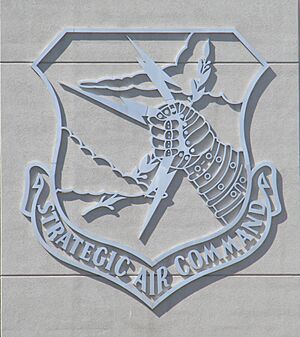- This page was last modified on 17 October 2025, at 10:18. Suggest an edit.
Strategic Air Command & Aerospace Museum facts for kids
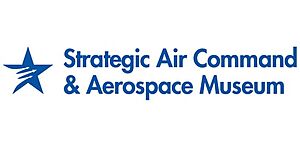 |
|
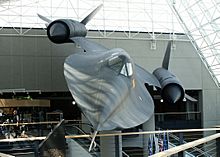
Lockheed SR-71 Blackbird on display
|
|
| Lua error in Module:Location_map at line 420: attempt to index field 'wikibase' (a nil value). | |
| Former name |
|
|---|---|
| Established | 1959, 1998 |
| Location | Ashland, Nebraska (1998– ) Offutt AFB (1959–1998) |
| Type | Aviation museum |
| Founder | Col. A. A. Arnhym |
The Strategic Air Command & Aerospace Museum is a cool place to learn about airplanes and nuclear missiles. These machines were important during the Cold War, a time when countries were in a tense standoff. The museum is located near Ashland, Nebraska, close to Omaha.
Its main goal is to keep and show off historic aircraft, missiles, and space vehicles. It also offers fun ways to learn about these amazing machines.
Contents
Museum History
How It Started
The museum began in 1959 at Offutt Air Force Base in Nebraska. This base was the main office for the Strategic Air Command (SAC). SAC was a big part of the United States Air Force. It was in charge of long-range bombers and missiles.
General Curtis LeMay had a dream to save these important aircraft. His dream came true when the museum opened. At first, it was called the Strategic Aerospace Museum. Over the years, its name changed a few times. It was also known as the Strategic Air Command Museum. In 1970, the state of Nebraska took over running the museum.
A New Home for the Museum
By 1995, many of the outdoor airplanes were getting old and damaged by the weather. People worried they might have to move the planes to other places. But three people, Robert Daugherty, Walter Scott Jr., and Lee Seemann, stepped up. They each gave $4 million to help build a new museum. Other donations helped raise a total of $32 million.
On May 16, 1998, the museum moved to a new indoor building. This new spot was easier for visitors to reach, located between Omaha and Lincoln. Now, the aircraft could be safe from rain, snow, and sun. Two large planes, a Douglas C-124 Globemaster II and a Douglas C-133 Cargomaster, moved to another museum in Delaware.
The new museum building cost $29.5 million. It is huge, about 300,000 square feet! It has a beautiful glass entrance area. There are two big hangars to display aircraft. You can also find a special area for traveling exhibits. Kids love the interactive gallery just for them. The museum also has a theater, a gift shop, and a snack bar.
A Lockheed SR-71 Blackbird airplane hangs in the glass entrance area. It's surrounded by 525 glass panels. The two large hangars keep the aircraft collection safe. The museum often trades exhibits with other national museums. This means you can see new things in the traveling exhibit area. Four large missiles are displayed outside the museum.
In 2001, the museum changed its name to the Strategic Air & Space Museum. This was to show it also focused on space. But many veterans didn't like this name. So, on June 25, 2015, the museum changed its name again. It became the Strategic Air Command & Aerospace Museum, which is its name today.
What You Can See
The museum has an amazing collection of aircraft, rockets, missiles, and spacecraft. It's like a journey through aviation and space history!
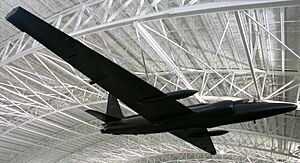
Lockheed U-2C on display
Amazing Aircraft
You can see many different types of airplanes here. Some are huge bombers, and others are fast fighter jets.
- Avro Vulcan B.2 XM573
- Boeing DB-17P Flying Fortress 44-83559
- Boeing B-47E Stratojet 52-1412
- Boeing EC-135C 63-8049
- Boeing KC-97G Stratofreighter 53-0198
- Boeing RB-52B Stratofortress 52-8711
- Boeing TB-29 Superfortress 44-84076
- Convair B-36J 52-2217
- Convair B-58A Hustler 61-2059
- Convair F-102A Delta Dagger 54-1405
- Convair T-29A 50-0190
- Douglas A-26B Invader 44-34665
- Douglas C-47A Skytrain 43-48098
- Douglas C-54D Skymaster 42-72724
- Fairchild C-119G Flying Boxcar 51-8024L
- General Atomics MQ-1C Gray Eagle
- General Dynamics FB-111A Aardvark 68-0267
- Grumman HU-16B Albatross 51-0006
- Lockheed F-117 Nighthawk 85-0831
- Lockheed T-33A 58-0548
- Lockheed U-2C 56-6701
- Lockheed SR-71A Blackbird 61-7964
- Martin B-57E Canberra 55-4244
- McDonnell XF-85 Goblin 46-0524
- McDonnell F-101B Voodoo 59-0462
- McDonnell RF-4C Phantom II 65-0903
- Mikoyan-Gurevich MiG-21F-13 60-2105
- Mikoyan-Gurevich MiG-23
- North American JTB-25N Mitchell 44-30363
- North American TB-25N Mitchell 44-28738 – This is just the front part of the plane.
- North American F-86H Sabre 53-1375
- North American RB-45C Tornado 48-0017
- North American T-39A Sabreliner 62-4487
- Piasecki CH-21B 52-8676
- Republic F-84F Thunderstreak 51-1714
- Republic F-105D Thunderchief 61-0069 – You can find this one outside at I-80W Mile Marker 428.2.
- Rockwell B-1A Lancer 76-0174
- Sikorsky H-19B Chickasaw 53-4426
Rockets and Missiles
The museum also displays powerful rockets and missiles. These were important tools during the Cold War.
- Boeing AGM-86B ALCM
- Chance Vought SLV-1 Blue Scout
- Convair SM-65D Atlas
- Douglas PGM-17A Thor
- McDonnell GAM-72 Quail
- Northrop SM-62 Snark
- North American GAM-77 Hound Dog
Spacecraft on Display
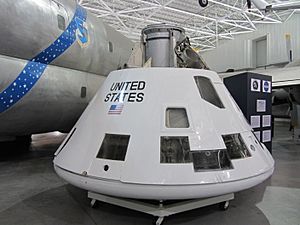
The collection includes the Apollo Block 1 command module from the Apollo program's uncrewed February, 1966, AS-201 mission
You can even see real spacecraft that have traveled beyond Earth!
- Apollo Block I Command Module CSM-009 – This module flew on the AS-201 mission.
- Apollo Boilerplate Command Module – This was a test version of the Apollo module.
- NASA X-38 – A prototype for a future crew return vehicle.
- Project Vela Satellite – A satellite used to detect nuclear explosions.

